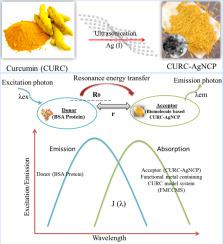Journal of Inorganic Biochemistry ( IF 3.8 ) Pub Date : 2020-08-20 , DOI: 10.1016/j.jinorgbio.2020.111210 Amol A Shedge 1 , Shubham V Pansare 2 , Shyam R Khairkar 3 , Shraddha Y Chhatre 4 , S Chakrabarti 2 , Amit A Nagarkar 5 , Amol V Pansare 6 , Vishwanath R Patil 1

|
Curcumin, a constituent of Curcuma longa L-Zingiberaceae is used in traditional Indian and worldwide medicine and shows anticancer and antioxidant properties. Curcumin has numerous biological and pharmacological activities but due to its hydrophobic nature, the major drawback is poor absorption and rapid elimination, rendering curcumin with the tag of a poor biomaterial. Hence, there is a need to develop functional metal containing curcumin model systems (FMCCMS) as a metallo-biomolecule to enhance the bioavailability of curcumin. We designed the interaction of silver metal ion with curcumin to form curcumin-silver nanocomposite (CURC-AgNCP) via ultrasonic synthetic route. Formations of FMCCMS were characterized by spectroscopic techniques. The crystalline face-centered cubic pattern and particle size of the nanocomposite was evaluated using X-ray diffraction and high-resolution transmission electron microscopy. The bonding of silver metal to curcumin was confirmed by X-ray photon spectroscopy. Interaction of the nanocomposite with bovine serum albumin (BSA) protein was performed using excitation, emission, and circular dichroism spectroscopy. In binding interaction of BSA, the negative value of ∆S° (−358.04 J mol−1 K−1) and ∆H° (−129.42 KJ mol−1) demonstrates the hydrophilic nature of the nanocomposite. The binding distance r evaluated according to the Forster resonance energy transfer theory and was 4.69 nm for CURC-AgNCP, which suggested non-radiative transfer of energy between CURC-AgNCP and BSA. The role of FMCCMS metallo-biomolecule CURC-AgNCP in medicine for cancer activity can have immense importance and hence we performed Sulphorhodamine B based in-vitro cytotoxicity assay on human breast cancer Michigan Cancer Foundation-7 cell line.
中文翻译:

含有姜黄素的功能性金属银纳米复合材料生物分子模型系统:蛋白质 BSA 生物利用度
姜黄素,姜黄的一种成分L-姜科用于印度和世界各地的传统医学,具有抗癌和抗氧化特性。姜黄素具有多种生物和药理活性,但由于其疏水性,其主要缺点是吸收差和消除快,使姜黄素具有不良生物材料的标签。因此,需要开发含有姜黄素的功能性金属模型系统(FMCCMS)作为金属生物分子,以提高姜黄素的生物利用度。我们设计了银金属离子与姜黄素的相互作用,通过超声波合成路线形成姜黄素-银纳米复合材料(CURC-AgNCP)。FMCCMS的形成通过光谱技术表征。使用 X 射线衍射和高分辨率透射电子显微镜评估纳米复合材料的晶面心立方图案和粒径。X 射线光子光谱证实了银金属与姜黄素的结合。纳米复合材料与牛血清白蛋白 (BSA) 蛋白的相互作用使用激发、发射和圆二色光谱进行。在BSA的结合相互作用中,Δ的负值S° (-358.04 J mol -1 K -1 ) 和 ∆ H° (-129.42 KJ mol -1 ) 表明纳米复合材料的亲水性。根据 Forster 共振能量转移理论评估的结合距离r为 4.69 nm 的 CURC-AgNCP,这表明 CURC-AgNCP 和 BSA 之间的非辐射能量转移。FMCCMS 金属生物分子 CURC-AgNCP 在药物治疗癌症活性方面的作用非常重要,因此我们对人乳腺癌密歇根癌症基金会 7 细胞系进行了基于 Sulphorhodamine B 的体外细胞毒性测定。











































 京公网安备 11010802027423号
京公网安备 11010802027423号